“I am not a runner.” This is something I have told myself and others for years. In fact, I remember way back in elementary school PE class thinking something was wrong with me. I excelled at most sporting activities my whole life. Not a superstar professional athlete, but enough to earn All-American honors at a Division I college.
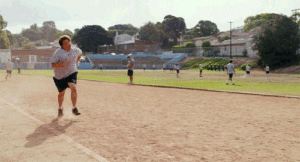 But as we explored more types of physical activity in school, I found that there was one area I was mediocre. I specifically remember the one mile run we had to do. When the whistle blew I was off to the races, clearly in the lead and ready to claim my school’s fastest mile runner prize. But then something happened. A classmate passed me. And then another and another. Pretty soon I was at the back of the back feeling like I couldn’t breath and ready to throw up.
But as we explored more types of physical activity in school, I found that there was one area I was mediocre. I specifically remember the one mile run we had to do. When the whistle blew I was off to the races, clearly in the lead and ready to claim my school’s fastest mile runner prize. But then something happened. A classmate passed me. And then another and another. Pretty soon I was at the back of the back feeling like I couldn’t breath and ready to throw up.
I came to the conclusion that there must have been something wrong that I didn’t win this race. So I concluded that I had asthma (self-diagnosed in 5th grade) and told my teacher I couldn’t do this activity anymore. My parents still remind me of how they were shocked to found our from my teacher that I all of a sudden was stricken with asthma.
Running still is a weakness to me. While I have taken it more seriously over the years, I know it is my Achilles Heel. The progress I have made, however, has been astounding. It is funny to look back at my older training philosophies and methodologies, and see how it has evolved over the past decade from own training program, plus working with hundreds of clients.
While it may be my weakness, it is something I have studied and practices over the years to develop an proven system that gets people better. Now I work with a variety of clients. Most of my clients are interested in becoming healthy, finding the best version of themselves, and losing unwanted body fat. Over the past few years though, I have worked with more and more clients interested in training for an Obstacle Course Race (OCR) like the Spartan Race.
Despite these seemingly different training goals, their endurance programs have the same underlying principles, and have more in common than you might think.
While I still joke that I am not a runner, deep down I understand that for my personal goal of improving my performance in my Spartan Racing, I need to run. And until I start to accept this concept, I would get beat by more racers than I would like. My 5th grade self would just claim I must have a disadvantage, but my present day self realized where the change needed to take place.
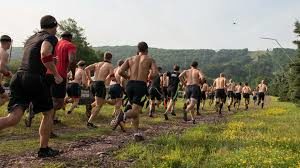 A running or cardio training program, whether you are training for a race or improved health, should have some similarities. Based on what type of race you may be training for or your specific goals, the specifics will vary, such as how long you should run, pace, etc. For the purpose of this article, I wanted to discuss more general programming that you should consider.
A running or cardio training program, whether you are training for a race or improved health, should have some similarities. Based on what type of race you may be training for or your specific goals, the specifics will vary, such as how long you should run, pace, etc. For the purpose of this article, I wanted to discuss more general programming that you should consider.
I could get incredibly detailed and explain all of the physiological changes that will occur based on the type of training you do, but again let’s keep this simple. My goal here is to show you that when you run or do cardio workouts, there must be a specific goal in mind and that all workouts are not created equal.
In my mind there are 3 workouts that everyone should include in there program. Now each type of workout has different subcategories, but again let’s keep this simple so you can apply it easier.
Workout #1 Long Slow Distance
 Low intensity cardio or running is not dead and should be an integral part of your routine. With the High Intensity Interval Training (HIIT) craze, many “experts” will say that traditional low intensity workouts are dead and counterproductive. This couldn’t be further from the truth and just shows how dramatic people tend to be.
Low intensity cardio or running is not dead and should be an integral part of your routine. With the High Intensity Interval Training (HIIT) craze, many “experts” will say that traditional low intensity workouts are dead and counterproductive. This couldn’t be further from the truth and just shows how dramatic people tend to be.
These workouts tend to be longer in duration (60 min or more), but at lower intensities (75% of Max HR or less). This would be the type of workout that you could do and still hold a conversation during.
These types of workouts expose you to longer time under tension. If you are getting ready for a longer race you need to be use to running or moving for extended period of times. HIIT workouts are great and we will mention them later, but there is a lot to say for just being on your feet for a long time that HIIT won’t help with.
These workouts are also critical for improving your aerobic capacity, boosting your VO2 max, increasing mitochondrial density, and enhancing fat metabolism. I know I said I wouldn’t get into physiology, but these are important to bring up. Aerobic capacity is the highest effort you can maintain while producing energy aerobically. This is likely a result of the other items I mentioned. You increase your VO2 max meaning you can consume more oxygen to use for energy. You have more mitochondria so you can produce more energy aerobically and use more fat for fuel, sparing your sugar stores. This means you will be more efficient for longer and be more fat adapted.
I think using a HR monitor is incredibly important to determine how your workouts are actually going. Here is a pic of a long slow distance workout I did.
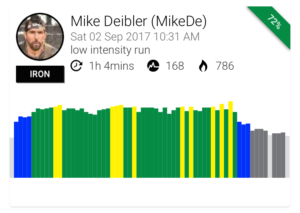
Notice my HR stays pretty consistent the entire race. If I saw my HR get too high, I simply slow down my pace. Or if it gets to low I pick it up. The idea here is to stay at or below that 75%. Ideally you can get tested to see exactly what HR your aerobic and anaerobic capacities are, but this is a good start.
Workout 2: Tempo Training
 Yes, there are drawbacks to longer training sessions. The longer you go the more likely something can go wrong. And since it is more time under tension it is more impact on the joints. This is why we must monitor how many miles we are putting in each week.
Yes, there are drawbacks to longer training sessions. The longer you go the more likely something can go wrong. And since it is more time under tension it is more impact on the joints. This is why we must monitor how many miles we are putting in each week.
To help reducing the time under tension for the rest of the week, we will incorporate our higher intensity workouts.
First up is tempo training. This is often referred to as race pace. This would be the pace you would average if you were performing a race. It is usually harder or faster than you typically would want to run.
There are a host of other physiological adaptations that occur with this type of training like improve anaerobic capacity and increasing lactate threshold. This is similar to our last workout but now we are at the other end of the spectrum. Now our goal is to maintain the hardest pace we can do for an extended time.
Please note that we are not doing HIIT here. This is higher intensity but not the highest. Your goal for this workout is to maintain the highest pace you can for anywhere from 20-45 minutes typically. Heart rate goals are usually around 80-85% but if you know your anaerobic threshold you can get much more specific.
Again here is what a tempo workout would look like if you were tracking with an HR monitor.
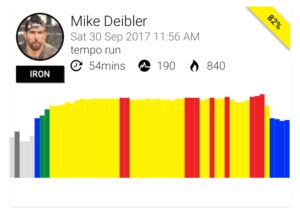
The hard part of these workouts is making sure you are pushing hard enough, but not so hard you can’t make it to the end. You really want to try and maintain the same pace for the entire workout. This will take some practice so you learn to not going our too hard.
Workout 3 High Intensity Interval Training
 Here is the fun part. Now we are going to see what you are made of. Many are not willing to push themselves hard enough to truly reap the benefits of this type of workout. There are many forms of interval training, so I do need to clarify what I am talking about here.
Here is the fun part. Now we are going to see what you are made of. Many are not willing to push themselves hard enough to truly reap the benefits of this type of workout. There are many forms of interval training, so I do need to clarify what I am talking about here.
Interval training simple means alternating between a harder effort with a lighter effort. This could be a jog and walk for some or a sprint and job for others. The distinction between interval training and HIIT is the effort.
To truly be HIIT you must hit intensities at or above your anaerobic threshold. This we typically see around 85% of your max HR, but again if you get tested you will know the exact HR.
You probably realize that you can’t sprint for very long. If you try you will eventually slow down until your body shuts you down in some form with cramping, vomiting, or some other fun activity. But if you sprint then recovery and sprint again, we see you can keep your HR elevated at a high intensity, even when you are not working any more.
This is the beauty behind intervals. Once you stop your HR continues to climb for a few moments, and then will drop back down. Again our bodies go through a number of adaptations to this type of training. Many we have already listed, but this form of training gets us use to higher speeds, higher efforts, and higher levels of discomfort.
As I mentioned there are different work to rest ratios we can do. You can perform all our sprints for 10 seconds and rest for 3 minutes. Or you can run as hard as you can for 3 minutes and rest until adequately recovered.
In my experience, sprinting is often where many injuries occur. I am hesitant to prescribe all out sprints unless a solid foundation is build and their body can handle this amount of stress. But longer intervals are a great place to start. By longer I am referring to anywhere from 1-3 minutes of hard effort.
With this length interval, you will not be able to run all out but you still can run a fast pace. This way we reduce the risk of injuries, but still can hit those high intensities.
Now how long should you recover? Often this with length of interval you will see a 1:1 or 1:2 work to rest ratio. This works for many, but again if you can use a monitor we can get much more specific.
If you are new to intervals you will run your 1-3 minutes at or above 85% and then rest until your hit 60%. If you are experienced with interval training than you start up again when you hit 65%.
The recovery is important though. You will notice if you are not recovered enough you will not be able to hit the high intensity nor maintain it for long enough. So, again you may have to play with these numbers a bit.
Below is an example of a 5X4 minute interval with recovery to 60%.
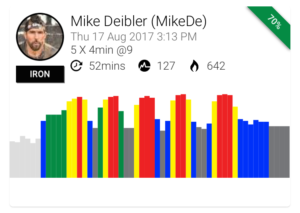
I hope these pictures really show you the difference between all of these workouts, and give you an idea of how your running or cardio should be. As I mentioned in the beginning of this post, when you are training for a competition or trying to lose a few pounds, this template will work great.
If you don’t have a HR monitor I strongly recommend you research into purchasing one. In fact to push you to get one so you can train smarter, I am going to give you a little incentive.
My personal brand of choice is the My Zone MZ-3 belt. This has a rechargeable belt which is incredibly convenient, but the best part is you can join my facility and I can track your workouts. Anyone that purchases a belt through the link below gets a free week of coaching by me. I will check out your workouts after you complete them and let you know how they look and where you could improve.
To take advantage of this just click the link below to grab your belt. Then just email your receipt to mike@ocrunderground.com.
By the way, if you use the link below you get $50 off your purchase!
http://buy.myzone.org/ship/?lang=enUS&voucher=SDPTUS001
Mike Deibler MS, CSCS, SGX
OCR Underground
www.ocrunderground.com

